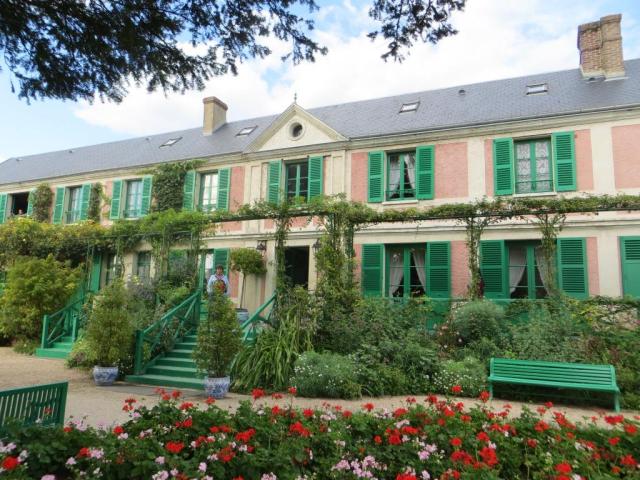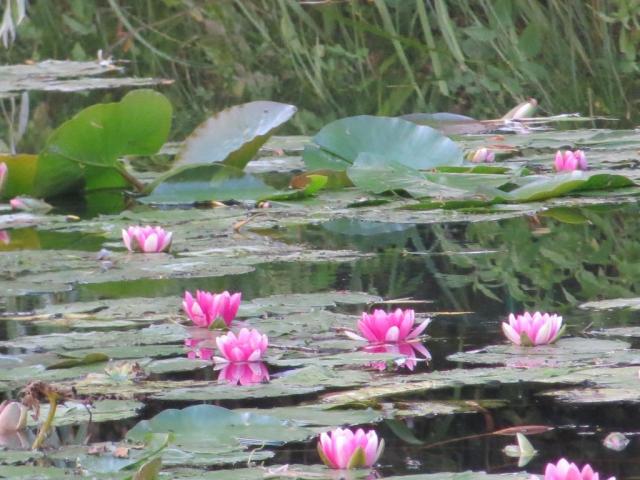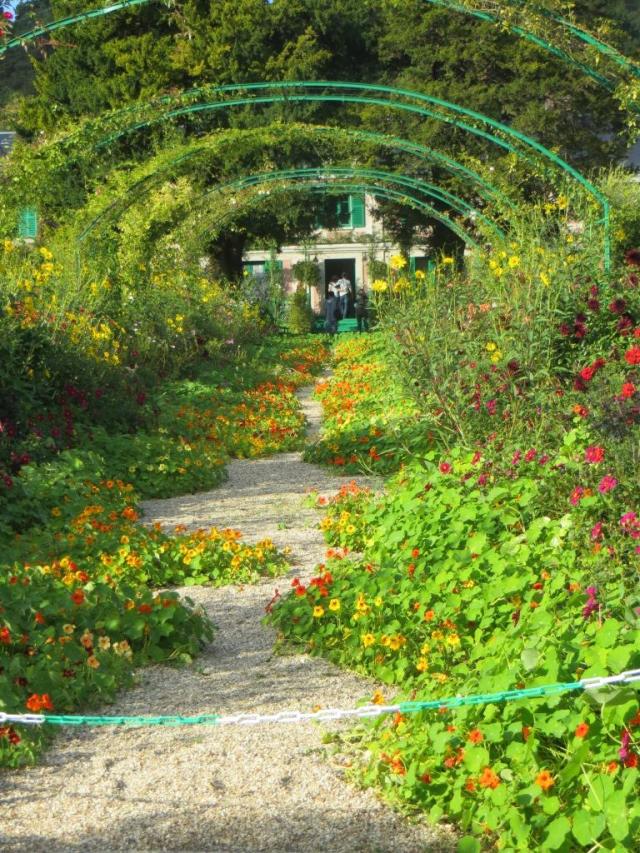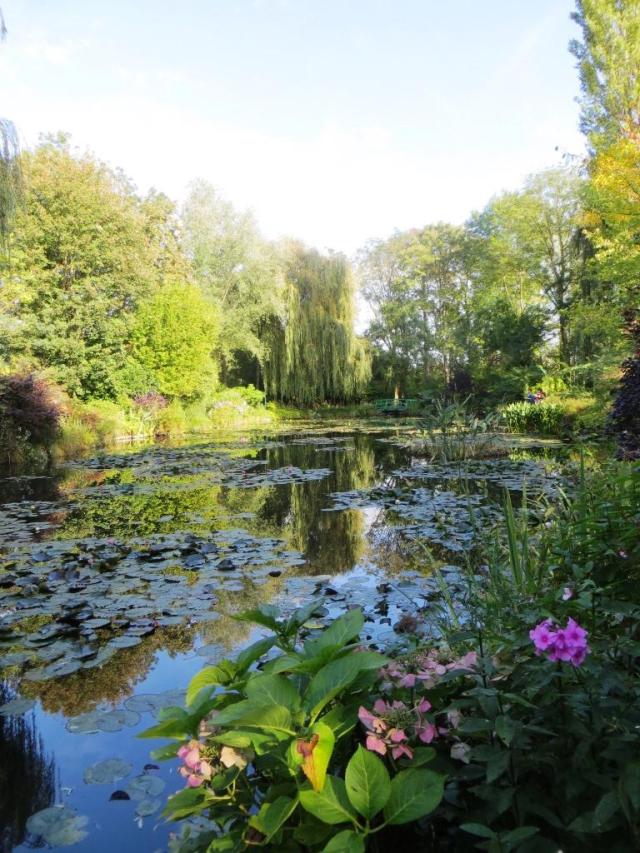Most people have heard of Claude Monet (1840-1926), one of the founders of French Impressionist painting. Many people know about and/or have visited his house at Giverny in Normandy, where he landscaped the gardens and developed the lily ponds that he immortalised in many of his paintings. We made our first visit at the end of September, on our way up to the UK.
As always, our journey was not without incident. Our GPS consistently tried to take us into central Paris. We resisted, even though this involved taking a motorway that went through a 14 km long tunnel (which did nothing for my claustrophobia) and turning left serially in Nanterre, where we realised we were going around in circles. Once on the correct route we were able to relax somewhat, but it meant we arrived at Giverny rather later than planned.
We had booked into a chambres d’hôtes at the entrance to the village, Les Jardins d’Hélène. Sandrine, the delightful owner, regarded us in horror when we arrived at 4.15 pm and said we had prepaid tickets to the Monet house and garden.
“Go, go, go!” she said. We did.
We were fortunate. Not only were we able to park in the car park opposite the garden but we were also able to get in very quickly. Most of the visitors were on their way out.
Monet first rented the house and two acres of land in early 1883. His artistic reputation, and his income, increased, and he was able to buy the property in 1890. He developed the gardens and bought additional land in 1893, including the water meadows on which he created his famous lily ponds.
By the end of the 19th century, he was painting numerous views of the water lily ponds, complete with Japanese-style bridge. These scenes became an integral part of his work. Despite employing numerous gardeners, he retained control of the architecture of the garden and the planting schemes.
His house is not huge. Rather, it is long and narrow. Sandrine said, “In May and June, it’s so busy that you can’t even get into the house.”
We could well believe this. Even at the end of an afternoon in late September, we felt we had to keep moving on in the house and couldn’t linger to look at things. We especially liked his study at one end of the house and the kitchen at the other, with its immense range.
However, we were really there to see the gardens. And they were sublime – even in early autumn.
The only false note was struck by the fact that a busy main road now separates the main garden from the lily ponds. Thanks to the generosity of a benefactor, you can walk through an underpass between the two. Nonetheless, the sound of juggernauts and coaches thundering along did rather spoil the general effect. No doubt in Monet’s day, the road was a simple cart track.
We were sorry not to be able to spend longer at Giverny. The house and gardens close at 18h00 sharp. And Sandrine’s chambres d’hôtes was a real find. Her place is a typical Norman late 19th-century house. She has thought of every possible detail: bottles of water on the bedside tables; Q-tips and make-up remover pads in the bathroom; elegant and comfortable furnishings throughout. And the breakfast was copious: a far cry from some of the cost-cutting B&Bs where we’ve stayed elsewhere in France.
Regretfully, we had to leave early the next morning to ensure we caught our ferry from Calais. Phalanxes of coaches were already arriving in Giverny.
You might also like:
Glorious French Gardens
Les Jardins de Quercy Revisited
Dry Gardening
Copyright © 2014 Life on La Lune, all rights reserved







[…] Monet’s Garden at Giverny […]
LikeLike
[…] Monet’s Garden at Giverny […]
LikeLike
[…] Monet’s Garden at Giverny […]
LikeLike
[…] Monet’s Garden at Giverny […]
LikeLike
It was a dusty road and a railway that ran side by side in Monet’s day, before the railway got rerouted on the south side of the Seine. Monet loved the railway and liked the element of modernity that the impressionists sought to capture with their atmospheric smoke and steam. In the end though, the passing cars wafted up too much dirt which covered his precious flowers so he paid to tarmac the road out of his own pocket!
So glad you went to visit, and eek yes, last entry is 4.30 so you only just made it!
I’m planning to take a photo from the same position every week when I go to watch the progression of flowers. I don’t think even with the greatest effort I would ever be able to recreate it though, my own garden seems to fight back!
Happy gardening!
LikeLiked by 1 person
How interesting! I never heard that aspect of the story. We went in September 2014, so almost four years ago. I would like to go at other times of year, but I imagine there are certain seasons when you can hardly move. I would love to go back. I am a great fan of Normandy, but we are rarely in that part of France.
The next best thing is to see your photos. So I shall look out for them.
LikeLike
[…] How to Garden in France: Which Plants do Well? Dry Gardening Glorious French Gardens Monet’s Garden at Giverny […]
LikeLike
Reblogged this on Crooked Cat's Cradle.
LikeLike
I’ve never been – I should of course and I am sure I will but in the meantime your sublime pictures capture the artist and the garden perfectly. Just the tonic for a rather stressful Sunday (!) evening ….
LikeLike
Do go if you can. It’s a wonderful place. But, of course, it is overrun with tourists. Sorry about your stressful time. I find gardens very therapeutic. We have a lovely garden close by; les Jardins de Quercy, about which I have blogged. I find it so peaceful.
LikeLike
Lovely photos! I went in 2007 and it was quiet because it was a rainy day. We were lucky though as it only rained once and this enhanced the experience, keeping the crowds low. Would love to go back and it’s easy to do on a day trip from Paris!
LikeLike
The crowds are a problem; but, of course, they have just as much right to see the place as we do! It’s an easy day trip from Paris and well worth the visit.
LikeLike
do SO love Monet’s garden – have been a few times at different times of the year – reading this must must must go again. We have a favourite little hotel on the river not far away.
LikeLike
This was our first visit. For whatever reason, we have not been before. It’s a good idea to avoid the busiest times of year in the late spring, when the garden is presumably at its best. But it’s then at its most popular. We were sorry not to have more time to spend there.
LikeLike